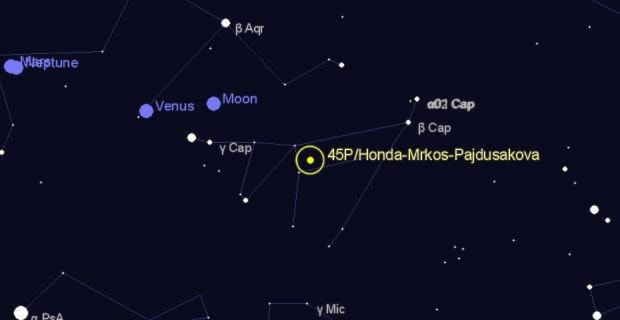Use Venus and Mars to find the zodiacal light, and eye two comets and an asteroid this month.
The crescent moon joins Venus, Mars, and Uranus in the southwest sky over Port Angeles and Metchosin just after sunset Feb. 1.
Watching Venus lately, it’s the brightest object in the night sky (except for the moon, of course). Through a telescope, you’re in for a real treat as the planet moves toward inferior conjunction – when the inner planet is directly between Earth and sun.
Though its lit crescent phase will thin, its apparent diameter increases, and Venus remains the same brightness all month long. It appears dimmer next month as the lit crescent becomes narrower and narrower.
Just above and left of Venus is Mars, posing with Uranus this month. Mars appears significantly brighter than Uranus, but you should still be able to see both with binoculars, though a telescope will reveal more detail. Mars will likely have a reddish tint to the human eye.
February isn’t a great meteor shower month, but you might see the zodiacal light, a triangular glow caused when sunlight reflects off dust particles in the plane of our solar system. Meteors are caused when dust particles from comets and asteroids burn up in Earth’s atmosphere. The zodiacal light is visible at sunset in late February and March. Use Venus and Mars as signposts to the cone-shaped glow on the western horizon over Langford. You’ll need a very dark sky to see it.
Comet 45P/ Honda-Mrkos-Pajdušáková, visible after sunset the last two months through both binoculars and telescopes, makes its closest approach Feb. 11, visible in the morning sky in the constellation Hercules at 5 p.m. below the Moon.
The orbit of 45P stretches out to Jupiter, but every 5.3 years it passes closer to the sun, between the orbits of Venus and Mercury. These short period comets orbit the sun like all the planets. Halley and 67P are two of the most famous.
The comet then passes through the constellations Corona Borealis (the “Northern Crown,” Bootes (the Herdsman), Canes Venatici (Bootes’ hunting dogs) and Ursa Major, then on to Leo by the end of February. It moves swiftly -- 9 degrees each day. It returns in 2022.
Comet 2P Encke also returns to our view after a 3.3 years. Find it in the constellation Pisces, visible through binoculars all month.
Finally, the brightest asteroid, Vesta, remains easily visible near the stars Castor and Pollux in Gemini. At over 525km across, it’s a huge rocky asteroid. Find it around midnight directly south over Port Angeles below the bright star Pollox.
Dark Skies to all friends of Cattle Point Star Park.
Catch up on NASA’s missions at www.nasa.gov. Learn about the RASCals of Cattle Point at www.facebook.com/groups/VictoriaRASCals.
Summary is by Bill Smith and the RASCals of Cattle Point from What’s Up in February 2017 by NASA announcer and astronomer Jane Houston Jones with specific permission for localization to Cattle Point DARK SKY Urban Star Park and the Oak Bay News.
